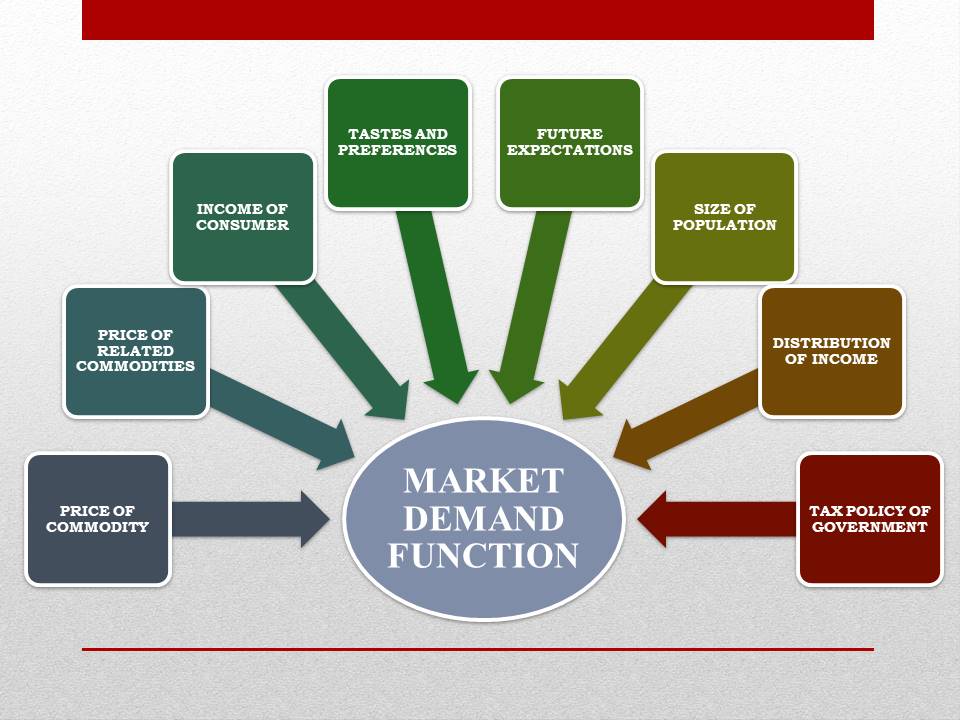DEMAND FUNCTION
OR
FACTORS AFFECTING DEMAND
OR
DETERMINANTS OF DEMAND
Demand function expresses the functional relationship between demand of the commodity and various factors affecting it. In other words, demand function describes the relationship between quantities of the commodity which consumers demand during a specified period and the factor which influence the demand.
It is of two types:
- Individual Demand Function
- Market Demand Function
INDIVIDUAL DEMAND FUNCTION
Individual Demand function expresses the functional relationship between demand for a particular product by an individual consumer and various factors affecting the demand for that product. In other words, it explains the factors affecting individual demand. It can be expressed as:
Dx= f (Px, Pr,Y, P, E)
- Dx = Demand of X commodity
- f= functional relationship
- Px= Price of good X
- Pr= Price of related goods
- P= Tastes and Preferences
- E= Future Expectations

The individual determinants of demand are explained as follows:
PRICE OF THE COMMODITY
The price of the commodity is an important determinant of demand. The price of the commodity is inversely or negatively related to its demand. If the price of the commodity is high, the demand of that commodity will be less. And if the price of the commodity falls, the demand of the commodity will be high.
PRICE OF RELATED GOODS
The demand for any commodity is also affected by the demand of related goods. The related goods are of two types:
- Substitute Commodities
- Complementary Commodities
SUBSTITUTE COMMODITIES: The commodities that can be used in place of each other are known as Substitute Commodities. There is positive relation between the price of one commodity and demand for another commodity in case of substitutes.
Example: Coke and Pepsi.
The increase in price of the coke will increase the demand of the Pepsi. The decrease in the price of the coke will decrease the demand of the Pepsi.
COMPLEMENTARY COMMODITIES: The commodities which are jointly used are known as complementary commodities. The use of complementary goods is not possible without one another.
Example: Car and Diesel
There is negative relation between the price of one commodity and demand for another commodity in case of complementary goods. The rise in the price of diesel will decrease the demand for the car and the fall in the price of the diesel with increase the demand for the car.
INCOME OF THE CONSUMER
The income of the consumer also affects the demand of commodity demanded by the consumer. There is a positive relationship between the income of the consumer and the quantity demanded by him. If the income of consumer increases, he will demand more. And if the income of the consumer decreases, he will demand the commodity less.
CONSUMER’S TASTES AND PREFERENCES
Every consumer has different choice for fashion, tastes and habits. The demand of those commodities will be more for which the consumer has favorable tastes and preferences. On the contrary, the demand for the commodity will be less to which the consumer dislikes.
FUTURE EXPECTATIONS
The future expectations regarding price will also affect the demand of that commodity. If there is expectation that the price of the commodity will rise in the future, the consumer will demand the commodity more in present. If there is tendency of fall in the price of the commodity in future, the consumer will demand less in present.
MARKET DEMAND FUNCTION
Market Demand Function expresses the functional relationship between total demand for a specific commodity made by all the consumers present in the market and various factors affecting that demand. In other words, the market demand function explains the factors which influence the market demand. It can be expressed as:
Dx= f (Px, Pr,Y, P, E, N, YD, T)
- Dx = Demand of X commodity
- f= functional relationship
- Px= Price of good X
- Pr= Price of related goods
- P= Tastes and Preferences
- E= Future Expectations
- N= Size of population
- YD = Distribution of Income
- T= Tax Policy of Government

The market determinants of demand are explained as follows:
SIZE OF POPULATION
The demand for the commodity also gets affected by the size of the population. If the population of the country is more, people’s needs will be more and hence the demand will also be high. In the country where the population is small, the needs of the people will be less and the demand fr the products will be less.
DISTRIBUTION OF INCOME
The distribution of Income also affects the demand of the commodity. If there is equal distribution of income in the economy, the market demand will be high. This is so because the poor will also have sufficient money to demand and make purchases. But, if the distribution of income will be unequal, the market demand of the goods in that economy, will be low.
TAX POLICY OF THE GOVERNMENT
The government of the country levy various kinds of taxes such as Direct taxes and Indirect taxes. If the government imposes more taxes, the disposable income of the consumer will be low and the demand will be less. On the contrary, if the government imposes fewer taxes, the disposable income of the consumer will be high and the demand will be more. This is how; the tax policy of the government impacts the demand of the commodities.